
Concept explainers
(a)
Interpretation: The organic product that is formed in the given reaction is to be determined.
Concept introduction: The various organic reactions form different organic products with the help of the variety of reagents. Some of the organic compounds are formed by the characteristic action of the various
Answer to Problem 25.65P
The product of the given reaction is,
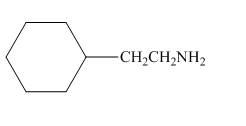
Explanation of Solution
The product formed by the reaction of the given

Figure 1
In the given reaction, nitrogen present in ammonia acts as a nucleophile and attacks at carbon atom which is directly attached with electronegative chlorine atom. Chlorine ion being a good leaving group, leaves the reactant site simultaneously which results in the formation of a desired
The product of the given reaction is shown in Figure 1.
(b)
Interpretation: The organic product that is formed in the given reaction is to be determined.
Concept introduction: The various organic reactions form different organic products with the help of the variety of reagents. Some of the organic compounds are formed by the characteristic action of the various functional groups present in them.
Answer to Problem 25.65P
The product of the given reaction is
Explanation of Solution
The product formed by the reaction of the given reactant with
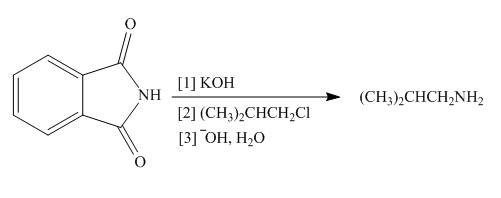
Figure 2
In the given reaction, nitrogen present in the given reaction is firstly reacts with
The product of the given reaction is
(c)
Interpretation: The organic product that is formed in the given reaction is to be determined.
Concept introduction: The various organic reactions form different organic products with the help of the variety of reagents. Some of the organic compounds are formed by the characteristic action of the various functional groups present in them.
Answer to Problem 25.65P
The product of the given reaction is,
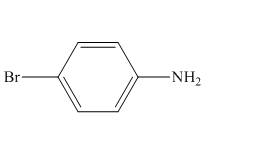
Explanation of Solution
The product formed by the reaction of given nitro compound with tin in the presence of an acid is shown as,

Figure 3
In the given reaction, nitro group of the reactant reacts with
The product of the given reaction is shown in Figure 3.
(d)
Interpretation: The organic product that is formed in the given reaction is to be determined.
Concept introduction: The various organic reactions form different organic products with the help of the variety of reagents. Some of the organic compounds are formed by the characteristic action of the various functional groups present in them.
Answer to Problem 25.65P
The product of the given reaction is,
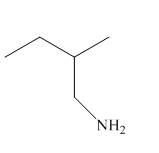
Explanation of Solution
The product formed by the reaction of given cyano compound with

Figure 4
In the given reaction, cyano group of the reactant reacts with lithium aluminum hydride that results in the reduction of cyano group into an amino group in the presence of water. Thus, lithium aluminum hydride being a strong reducing agent forms a desired amine product.
The product of the given reaction is shown in Figure 4.
(e)
Interpretation: The organic product that is formed in the given reaction is to be determined.
Concept introduction: The various organic reactions form different organic products with the help of the variety of reagents. Some of the organic compounds are formed by the characteristic action of the various functional groups present in them.
Answer to Problem 25.65P
The product of the given reaction is,

Explanation of Solution
The product formed by the reaction of given amide compound with

Figure 5
In the given reaction, amide group of the reactant reacts with lithium aluminum hydride that results in the reduction of amide group into an amino group in the presence of water. Thus, lithium aluminum hydride being a strong reducing agent forms a desired amine product.
The product of the given reaction is shown in Figure 5.
(f)
Interpretation: The organic product that is formed in the given reaction is to be determined.
Concept introduction: The various organic reactions form different organic products with the help of the variety of reagents. Some of the organic compounds are formed by the characteristic action of the various functional groups present in them.
Answer to Problem 25.65P
The product of the given reaction is,
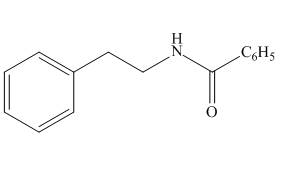
Explanation of Solution
The product formed by the reaction of given amine compound with an anhydride is shown as,

Figure 6
In the given reaction, amine group of the reactant reacts with the anhydride to form a desired amide product. This amide product is a secondary amide.
The product of the given reaction is shown in Figure 6.
(g)
Interpretation: The organic product that is formed in the given reaction is to be determined.
Concept introduction: The various organic reactions form different organic products with the help of the variety of reagents. Some of the organic compounds are formed by the characteristic action of the various functional groups present in them.
Answer to Problem 25.65P
The product of the given reaction is,
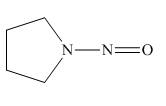
Explanation of Solution
The product formed by the reaction of given cyclic secondary amine with sodium nitrite in the presence of an acid is shown as,

Figure 7
In the given reaction, amine group of the reactant reacts with
The product of the given reaction is shown in Figure 7.
(h)
Interpretation: The organic product that is formed in the given reaction is to be determined.
Concept introduction: The various organic reactions form different organic products with the help of the variety of reagents. Some of the organic compounds are formed by the characteristic action of the various functional groups present in them.
Answer to Problem 25.65P
The product of the given reaction is,
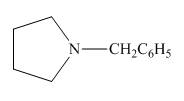
Explanation of Solution
The product formed by the reaction of given cyclic secondary amine with an

Figure 8
In the given reaction, amine group of the reactant reacts with benzaldehyde in the presence of
The product of the given reaction is shown in Figure 8.
(i)
Interpretation: The organic product that is formed in the given reaction is to be determined.
Concept introduction: The various organic reactions form different organic products with the help of the variety of reagents. Some of the organic compounds are formed by the characteristic action of the various functional groups present in them.
Answer to Problem 25.65P
The product of the given reaction is,
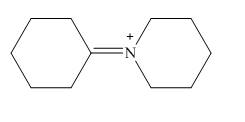
Explanation of Solution
The product formed by the reaction of given cyclic amine compound with an cyclic

Figure 9
In the given reaction, amine group of the reactant reacts with a cyclic ketonic compound to form a desired product.
The product of the given reaction is shown in Figure 9.
(j)
Interpretation: The organic product that is formed in the given reaction is to be determined.
Concept introduction: The various organic reactions form different organic products with the help of the variety of reagents. Some of the organic compounds are formed by the characteristic action of the various functional groups present in them.
Answer to Problem 25.65P
The product of the given reaction is
Explanation of Solution
The product formed by the reaction of given secondary amine compound with methyl iodide in the presence of

Figure 10
In the given reaction, amine group of the reactant reacts with
The product of the given reaction is
Want to see more full solutions like this?
Chapter 25 Solutions
Organic Chemistry
- In the decomposition reaction in solution B → C, only species C absorbs UV radiation, but neither B nor the solvent absorbs. If we call At the absorbance measured at any time, A0 the absorbance at the beginning of the reaction, and A∞ the absorbance at the end of the reaction, which of the expressions is valid? We assume that Beer's law is fulfilled.arrow_forward> You are trying to decide if there is a single reagent you can add that will make the following synthesis possible without any other major side products: 1. ☑ CI 2. H3O+ O Draw the missing reagent X you think will make this synthesis work in the drawing area below. If there is no reagent that will make your desired product in good yield or without complications, just check the box under the drawing area and leave it blank. Click and drag to start drawing a structure. Explanation Check ? DO 18 Ar B © 2025 McGraw Hill LLC. All Rights Reserved. Terms of Use | Privacy Center | Accessibilityarrow_forwardDon't use ai to answer I will report you answerarrow_forward
- Consider a solution of 0.00304 moles of 4-nitrobenzoic acid (pKa = 3.442) dissolved in 25 mL water and titrated with 0.0991 M NaOH. Calculate the pH at the equivalence pointarrow_forwardWhat is the name of the following compound? SiMe3arrow_forwardK Draw the starting structure that would lead to the major product shown under the provided conditions. Drawing 1. NaNH2 2. PhCH2Br 4 57°F Sunny Q Searcharrow_forward
- 7 Draw the starting alkyl bromide that would produce this alkyne under these conditions. F Drawing 1. NaNH2, A 2. H3O+ £ 4 Temps to rise Tomorrow Q Search H2arrow_forward7 Comment on the general features of the predicted (extremely simplified) ¹H- NMR spectrum of lycopene that is provided below. 00 6 57 PPM 3 2 1 0arrow_forwardIndicate the compound formula: dimethyl iodide (propyl) sulfonium.arrow_forward
 ChemistryChemistryISBN:9781305957404Author:Steven S. Zumdahl, Susan A. Zumdahl, Donald J. DeCostePublisher:Cengage Learning
ChemistryChemistryISBN:9781305957404Author:Steven S. Zumdahl, Susan A. Zumdahl, Donald J. DeCostePublisher:Cengage Learning ChemistryChemistryISBN:9781259911156Author:Raymond Chang Dr., Jason Overby ProfessorPublisher:McGraw-Hill Education
ChemistryChemistryISBN:9781259911156Author:Raymond Chang Dr., Jason Overby ProfessorPublisher:McGraw-Hill Education Principles of Instrumental AnalysisChemistryISBN:9781305577213Author:Douglas A. Skoog, F. James Holler, Stanley R. CrouchPublisher:Cengage Learning
Principles of Instrumental AnalysisChemistryISBN:9781305577213Author:Douglas A. Skoog, F. James Holler, Stanley R. CrouchPublisher:Cengage Learning Organic ChemistryChemistryISBN:9780078021558Author:Janice Gorzynski Smith Dr.Publisher:McGraw-Hill Education
Organic ChemistryChemistryISBN:9780078021558Author:Janice Gorzynski Smith Dr.Publisher:McGraw-Hill Education Chemistry: Principles and ReactionsChemistryISBN:9781305079373Author:William L. Masterton, Cecile N. HurleyPublisher:Cengage Learning
Chemistry: Principles and ReactionsChemistryISBN:9781305079373Author:William L. Masterton, Cecile N. HurleyPublisher:Cengage Learning Elementary Principles of Chemical Processes, Bind...ChemistryISBN:9781118431221Author:Richard M. Felder, Ronald W. Rousseau, Lisa G. BullardPublisher:WILEY
Elementary Principles of Chemical Processes, Bind...ChemistryISBN:9781118431221Author:Richard M. Felder, Ronald W. Rousseau, Lisa G. BullardPublisher:WILEY





